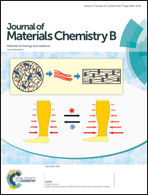A universal fluorometric assay strategy for glycosidases based on functional carbon quantum dots: β-galactosidase activity detection in vitro and in living cells†
Abstract
The development of highly sensitive assays for glycosidases is of critical significance to understand their functions, facilely detect associated diseases and screen potential new drugs. In this work, we develop a universal assay strategy for glycosidase enzymes and inhibitor screening based on functional carbon quantum dots through a combined host–guest recognition and specific static quenching-induced signal transduction mechanism. This detection strategy is established in terms of the following facts: (1) β-cyclodextrin as a perfect host can selectively associate with p-nitrophenol due to its hydrophobic character and right size match of the cavity, which renders specific binding between β-cyclodextrin and p-nitrophenol via a host–guest recognition. (2) The formation of an inclusion complex between β-cyclodextrin modified carbon quantum dots (β-CD–CQDs) and p-nitrophenol results in fluorescence quenching with a high quenching efficiency due to the static quenching mechanism. Glycoconjugates of p-nitrophenol as the substrates could be rapidly hydrolyzed to corresponding glycose and p-nitrophenol in the presence of specific glycosidase, and the resulting p-nitrophenol induces the following host–guest interaction and static quenching leading to a change in the fluorescence signal. The activity of different glycosidase enzymes could be evaluated in the same way as long as the glycosyl unit of glycosylated substrates was changed. Here we take β-galactosidase as an example to demonstrate the applicability of the proposed detection strategy because it can act as a molecular target for primary ovarian cancers. A highly sensitive assay for β-galactosidase activity in terms of linear correlation of the fluorescence change with the β-galactosidase level was established with a low detection limit of 0.6 U L−1. Its function of inhibitor screening was also assessed by using D-galactal as the inhibitor for β-galactosidase, and the positive results indicated its feasibility to screen potential inhibitors. It is also illustrated that the nanoprobe possesses excellent biocompatibility, and can sensitively monitor the intracellular β-galactosidase level in ovarian cancer cells. This work provides a general detection method for glycosidase activity, demonstrates its applicability of monitoring the enzyme level in living cells, and broadens fluorogenic probes in fluorescence-guided diagnostics.



 Please wait while we load your content...
Please wait while we load your content...